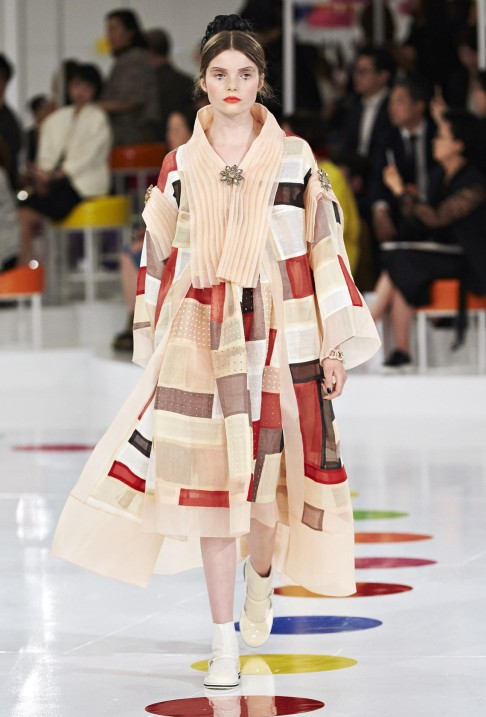
EXCLUSIVE: 'Asia is the future', Karl Lagerfeld says as Chanel holds Korea show
German designer's fondness for Korea runs deep, and Chanel's recent cruise show in the South Korean capital is just the first step
It was a vision of the future in more ways than one. Within the grand arching curves of Zaha Hadid's Dongdaemun Design Plaza building in the centre of Seoul, the likes of supermodel Gisele Bundchen (who recently retired from the runway), actors Tilda Swinton, Kristen Stewart and Gaspard Ulliel, K-pop titans G-Dragon and Taeyang gathered with VIPs for Chanel's cruise show.
The runway set-up reminded us of a child's futuristic board game. Playful outfits executed with colourful candy stripes and geometric graphics, thick braided black hairpieces referencing traditional Korean styles and eyes highlighted with cartoonish lashes and double pencilled eyebrows.
"It's funny that everyone takes inspiration from China," says German designer Karl Lagerfeld in his trademark black shades and white ponytail, referring to the stars that had gathered in New York for the China-themed Met Gala. "But not from Korea … I find that so interesting. So that's why I did the show here."

Lagerfeld says that South Koreans "live very much in the present", which puts them in tune with the fashion trends.
"Look at the streets here, they are young and playful," he says.
That's the vibe Lagerfeld tried to inject into his Korean-inspired collection. Loose, girlish baby-doll silhouettes dominated the runway, with blonde South Korean supermodel SooJoo Park leading the way. Colourful tweeds, wide pants cropped jauntily at the ankle and shiny vinyl textures made for a carefree, youthful attitude.

Sophisticated black dresses in embroidered couture-like fabrics were our favourites, a sentiment echoed by Bundchen.
Lagerfeld had taken inspiration not just from the rising power of K-pop, but also Korean tradition, which was obvious when Hanbok dresses closed his show.
Modern art also left a mark with the designer, particularly "oriental pieces with great patterns, but without a heavy connection to the past".

Although Lagerfeld once famously claimed he never goes on holidays, he obviously travels often due to work, which makes it easy for him to "pick up on all the details" of places he visits.
To say that South Korean pop culture is hot right now would be an understatement - so it's a smart move by the designer to focus on this market. In Asia, through the popularity of K-pop and soap operas, fans of South Korean stars are loyal and feverish. And the movement - (Korean wave) - is even gaining a following in North America.
Although Chanel is in an enviable position of success, it is still constantly looking for and analysing current and future trends.

"If one day we stop fuelling the brand, it will go down," says Bruno Pavlovsky, Chanel's president of fashion. "We need to keep things fresh. We have to know that just because we are successful today, it doesn't mean that we will be successful forever."
Through the years, Lagerfeld's knack for reinvention has kept Chanel, as well as his stable of brands such as Fendi and his eponymous label, relevant and modern. Creating specific points of view and narratives (without paying too much attention to other brands) is his strong suit.
"I think the Asian world is better than the old European world now. Asia is much more about the future, unlike Europeans, especially the French," says the designer, playfully.
Pavlovsky says Lagerfeld is "a genius, with an incredible capacity to create a true environment", not to mention uncanny compartmentalising abilities.
"When he comes to work for Chanel he works for Chanel, he will never be inspired in any other field when he is here. What he is doing for Fendi is for Fendi, and the same for his photography. He is able to move from one to another within the same day. I'm not sure I know other people who can do that at this level."
Chanel was the first major label to introduce destination shows back in 2005.
"Cruise" originally emerged as a between-season collection for the wealthy to wear on their holidays. It has become a major money earner for big brands.
Away from the mania of the twice-yearly women's ready-to-wear fashion weeks in New York, London, Milan and Paris (around March and October) where hundreds of brands battle for attention, cruise collections have become an important way for the label to engage and charm customers, buyers and press.
These shows, held in Dubai and Salzburg, focus on the content, says Pavlovsky, which is often inspired by the location.
"They are unique Chanel moments," he says.
But many other major brands are following suit and snapping at Chanel's ankles. For example, Louis Vuitton's cruise show in Palm Springs, California happened just days after Chanel's. Dior will have its in Cannes.
"Just to do a new show because the competition is doing it? I would question the content," says Pavlovsky. "At Chanel, we find the best way to protect this moment."

